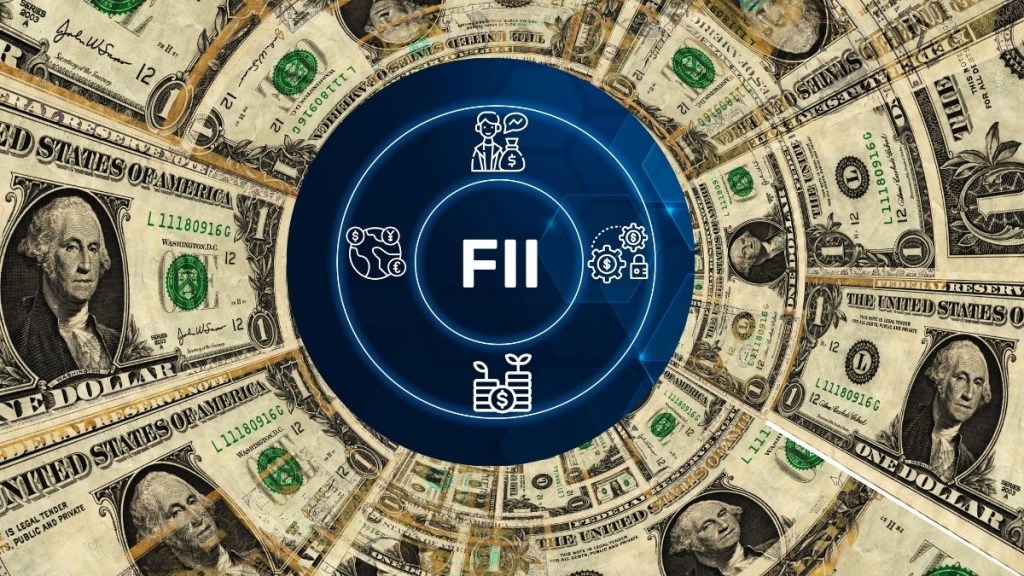The week ended on a positive note for Indian markets for more than one reason. Not only did the benchmark indices Nifty and Sensex close at the highest levels since January, the foreign institutional investors (FIIs) saw a comeback of sorts. FIIs bought (net of sales) equities worth as much as Rs 14,670 crore in the last three sessions of this holiday-shortened week. Is this a definitive trend reversal then or just a blip?
The key drivers for FII inflows include strong economic fundamentals and India’s relatively attractive valuations. These along with a host of global factors dictate the direction of flows globally.
The dollar’s strength was one of the key reasons that we saw a definitive flight to dollar denominated assets towards the last quarter of 2024, However, in the last two months, the dollar has lost a lot of its charm, making emerging market relatively more attractive.
But have the clouds of concerns completely faded?
Two big worries for FIIs in India
Here is a look at the two key factors that could impact the investment flows into India
India’s valuations vs other EMs
Though the Indian markets have seen significant correction lately, the MSCI India Index still trades around 20.02x earnings. This in comparison is significantly higher than the MSCI EM Index (Emerging Market index) which is trading close to 13x. This gap in valuations is significantly lower than during the 2021 peak but it is still significantly above the pre-pandemic 5-year average of around 6.5x.
SEBI’s disclosure proposal a roadblock?
The other big concern area for FPIs has been SEBI’s proposal to extend disclosure requirements for FPIs. According to SEBI, the granular disclosure limits for Foreign Portfolio Investors was increased to Rs 50,000 crore of assets under management from Rs 25,000 crore so far. While the market regulator maintained that the steps were initiated to bring about greater transparency and encourage better corporate governance, many experts are now wondering whether the move can be counterproductive.
Two factors that make a case for the ‘return of FIIs’ to India
However, there are some factors that could make a case for India in the current context.
Dollar Index trading below 100 for 3 days
The Dollar Index has been consistently trading below the 100 mark for the last three sessions. Over the last three months the Dollar Index has retraced ground significantly from the January 2025 highs of 110. In fact, it has been trading consistently below the key 100 level for the past three sessions and is down over 8% from its highs at the beginning of the year.
Essentially, the flight to dollar denominated assets were on the back of the greenback’s relative strength. Usually the dollar’s weakness leads to EM flows. This is because a weaker dollar would significantly cut down returns for the foreign investors. What’s interesting this time is a lot of that money is being redirected towards gold.
Gold surpasses $3,300/oz mark
But Gold has been scaling fresh highs. The Yellow metal recently breached $3,300 per ounce level, as a weaker dollar and escalating U.S.-China trade tensions pushed investors towards the safe-haven assets. Close on the heels of the 3% rise in gold rates, Citi has raised its 3-month target for gold prices to $3,500 per ounce from $3,200 on the back of fresh gold buying from Chinese insurers and safe-haven flows. Very high gold prices may start impacting the relatives returns for foreign investors. They are on the watch out for bargain buys and assets that promise maximum returns. The EM valuations compared to gold needs to analysed.
In conclusion, a weak dollar alone cannot determine the case for FIIs returning to India. While it is one of the triggers, India’s position relative to the global setup needs to be seen. A report by Goldman Sachs indicates that it anticipates that US investors may be forced to offload Chinese equities, given how the tariff war between US-China is panning out. Foreign investors have bought a significant amount of Chinese equities in the past 6 months. Moreover, most market observers in India believe that FPIs cannot make sudden changes in their allocations.
At best India may see incremental gains as we head towards the second half of 2025.

